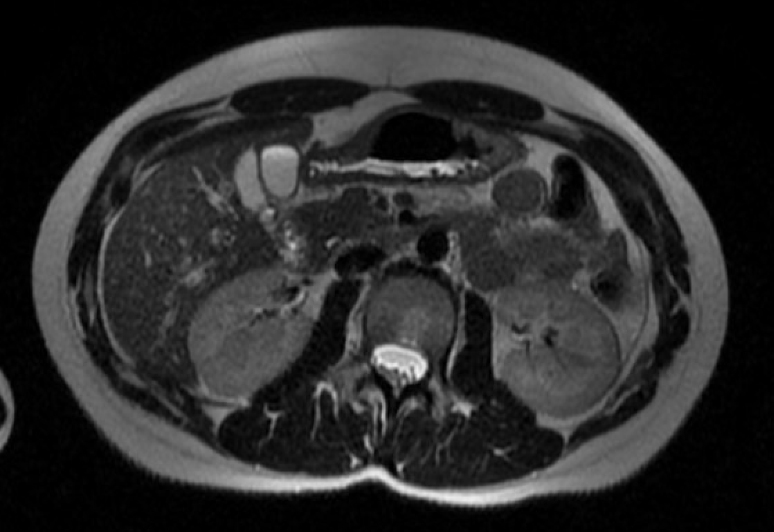Tuesday Poster Session
Category: Biliary/Pancreas
P4437 - Right Upper Quadrant Pain in Young Female With Duplicated Biliary System
Tuesday, October 28, 2025
10:30 AM - 4:00 PM PDT
Location: Exhibit Hall

Krishna Shah, MD
Advocate Christ Medical Center
Chicago, IL
Presenting Author(s)
Krishna Shah, MD1, Kamakshi Katwala, MD1, Regine Marie Lim, DO2, Matthew Posen, DO2, Rogelio Silva, MD2
1Advocate Christ Medical Center, Chicago, IL; 2Advocate Christ Medical Center, Oak Lawn, IL
Introduction: Extrahepatic biliary duplication is a rare congenital anomaly that can present at any time in life with varying degrees of symptoms. Below we present a case of duplicated gallbladder and common bile duct in a young female who presented with right upper quadrant pain.
Case Description/
Methods: 23 year old female with no past medical history who presented to her primary care physician with right upper quadrant pain. All laboratory results including alanine aminotransferase and aspartate aminotransferase, bilirubin and alkaline phosphatase were all within normal range. Given suspicion for biliary process despite normal laboratory values, patient was sent for a magnetic retrograde cholangiopancreatography (MRCP). MRCP was significant for apparent duplication of the gallbladder and common bile ducts [image 1]. Further workup with nuclear medicine HIDA scan was significant for a post-cholecystokinin gallbladder ejection fraction of 92%, which is consistent with biliary hyperkinesia. Given her high risk of symptom recurrence, patient has been referred to general surgery consultation for elective cholecystectomy; however she has decided to defer surgery at this time.
Discussion: Duplication of the biliary tree has several different anatomical variations including bilobed (common neck) ranging to full duplication of the gallbladder and entire biliary tree [1]. While many patients remain asymptomatic, many present with symptoms such as nausea, vomiting and right upper quadrant pain. These patients generally go to surgery which proves to be rather complex given the duplicated system usually which is not discovered until the patient is in surgery [2]. One study found that nearly 80% of pateints with duplicated biliary system are diagnosed intraoperatively [2]. This poses a unique surgical conundrum; and with no clear guidance, systems or classifications, poses a risk to both diagnosis and treatment. In this case, this patient presented with symptoms of biliary colic and was incidentally discovered to have these findings. Although MRCP is convincing, the HIDA scan only showed biliary hyperkinesis. It is important for this patient to have surgical planning to ensure safe extraction of both gallbladders to avoid complications such as cholecystitis, choledocholithiasis or cholangitis.

Figure: MRCP image depicting clearly 2 filled gallbladders in patients abdomen
Disclosures:
Krishna Shah indicated no relevant financial relationships.
Kamakshi Katwala indicated no relevant financial relationships.
Regine Marie Lim indicated no relevant financial relationships.
Matthew Posen indicated no relevant financial relationships.
Rogelio Silva indicated no relevant financial relationships.
Krishna Shah, MD1, Kamakshi Katwala, MD1, Regine Marie Lim, DO2, Matthew Posen, DO2, Rogelio Silva, MD2. P4437 - Right Upper Quadrant Pain in Young Female With Duplicated Biliary System, ACG 2025 Annual Scientific Meeting Abstracts. Phoenix, AZ: American College of Gastroenterology.
1Advocate Christ Medical Center, Chicago, IL; 2Advocate Christ Medical Center, Oak Lawn, IL
Introduction: Extrahepatic biliary duplication is a rare congenital anomaly that can present at any time in life with varying degrees of symptoms. Below we present a case of duplicated gallbladder and common bile duct in a young female who presented with right upper quadrant pain.
Case Description/
Methods: 23 year old female with no past medical history who presented to her primary care physician with right upper quadrant pain. All laboratory results including alanine aminotransferase and aspartate aminotransferase, bilirubin and alkaline phosphatase were all within normal range. Given suspicion for biliary process despite normal laboratory values, patient was sent for a magnetic retrograde cholangiopancreatography (MRCP). MRCP was significant for apparent duplication of the gallbladder and common bile ducts [image 1]. Further workup with nuclear medicine HIDA scan was significant for a post-cholecystokinin gallbladder ejection fraction of 92%, which is consistent with biliary hyperkinesia. Given her high risk of symptom recurrence, patient has been referred to general surgery consultation for elective cholecystectomy; however she has decided to defer surgery at this time.
Discussion: Duplication of the biliary tree has several different anatomical variations including bilobed (common neck) ranging to full duplication of the gallbladder and entire biliary tree [1]. While many patients remain asymptomatic, many present with symptoms such as nausea, vomiting and right upper quadrant pain. These patients generally go to surgery which proves to be rather complex given the duplicated system usually which is not discovered until the patient is in surgery [2]. One study found that nearly 80% of pateints with duplicated biliary system are diagnosed intraoperatively [2]. This poses a unique surgical conundrum; and with no clear guidance, systems or classifications, poses a risk to both diagnosis and treatment. In this case, this patient presented with symptoms of biliary colic and was incidentally discovered to have these findings. Although MRCP is convincing, the HIDA scan only showed biliary hyperkinesis. It is important for this patient to have surgical planning to ensure safe extraction of both gallbladders to avoid complications such as cholecystitis, choledocholithiasis or cholangitis.
Liu, X., et al. "Complete duplication of the biliary system: a case report and review of the literature." 2020
Nakahira, S., et al. "Congenital duplication of the gallbladder and biliary system." 2016

Figure: MRCP image depicting clearly 2 filled gallbladders in patients abdomen
Disclosures:
Krishna Shah indicated no relevant financial relationships.
Kamakshi Katwala indicated no relevant financial relationships.
Regine Marie Lim indicated no relevant financial relationships.
Matthew Posen indicated no relevant financial relationships.
Rogelio Silva indicated no relevant financial relationships.
Krishna Shah, MD1, Kamakshi Katwala, MD1, Regine Marie Lim, DO2, Matthew Posen, DO2, Rogelio Silva, MD2. P4437 - Right Upper Quadrant Pain in Young Female With Duplicated Biliary System, ACG 2025 Annual Scientific Meeting Abstracts. Phoenix, AZ: American College of Gastroenterology.
